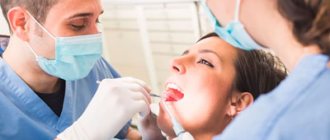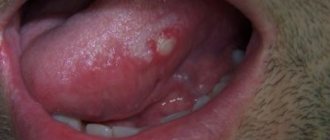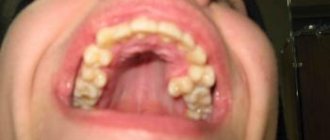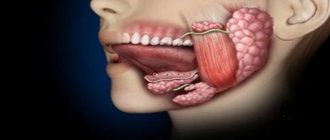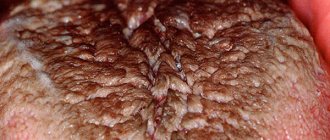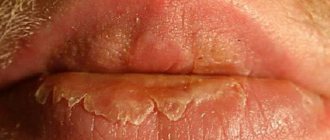Author:
- Khirnetkina Ayuna Fedorovna
otorhinolaryngologist, otoneurologist, audiologist
4.00 (Votes: 4)
In medicine, the term paratonsillar abscess refers to the accumulation of pus in the tissues surrounding the tonsils. The term “paratonsillitis/peritonsillitis” is also distinguished when purulent has not yet formed. This is the stage before the formation of the abscess itself.
Peritonsillitis and paratonsillar abscess occupy first place among purulent processes of the pharynx and are a consequence of the spread of an acute inflammatory process from the palatine tonsils to the paratonsillar tissue and surrounding tissues, characterized by their inflammatory infiltration (edema). More often there is a one-sided process. These conditions are a complication of acute or exacerbation of chronic tonsillitis, tonsillitis, due to trauma to the pharynx by a foreign body, odontogenic process (caries, periodontitis, etc.).
Peritonsillar abscesses belong to a group of diseases that require emergency care. For diffuse purulent inflammation of the peritonsillar tissue for 2 days, when an abscess has not yet formed, the treatment is the same as for a severe form of tonsillitis (lacunary or follicular). In the absence of positive dynamics, the patient is hospitalized. In cases where an abscess has formed (usually by the 5-6th day, and with some infections and a decrease in the body’s immunity, an abscess can form, despite active treatment, earlier - on the 3-4th day from the onset of the disease) it is necessary to perform his autopsy.
What is an abscess and what causes it?
An abscess is a painful pustule surrounded by inflamed tissue. Often it can be easily felt. Such a formation can appear on any part of the body, but most often it affects:
- armpits;
- area around the anus and vagina (Bartholin gland abscess);
- tissue around the tooth;
- skin in the groin area;
- hair follicles.
During their development, abscesses are filled with necrotic masses and can open on their own. However, it is best to consult a doctor in case of such a disease, who will open the purulent focus and clean (drain) it.
Causes of abscesses:
- as an independent disease, abscesses of the skin and soft tissues most often occur, caused by blockage of the openings of the sebaceous and sweat glands, the formation of cysts and the proliferation of pathogenic microorganisms there;
- purulent soft tissue abscess can be a complication of skin damage;
- a post-injection abscess develops when the drug is administered with a non-sterile syringe; in severe cases, a purulent process – phlegmon – may spread;
- such a process often complicates the course of any infectious diseases of a bacterial nature, for example, a peritonsillar abscess develops as a complication of tonsillitis;
- Abdominal abscesses can develop when microbes are transferred through blood vessels;
- in some cases, the cause of the disease is not bacteria, but protozoan microorganisms, for example, amoebic liver abscess;
- pathology may arise primarily due to the penetration of a large number of pathogens with high virulence (damaging ability) into the tissues, and a lung abscess may form.
Signs of an abscess occur more often in people with weakened immune systems. Risk factors for developing pathology:
- long-term treatment with glucocorticoids and chemotherapy drugs;
- diabetes mellitus, malignant tumors;
- diseases of the blood and hematopoiesis – sickle cell anemia, leukemia, HIV infection;
- Crohn's disease, ulcerative colitis;
- severe injuries or burns;
- alcoholism, drug addiction.
Other risk factors are exposure to a polluted environment, contact with dust, hydrocarbons, poor skin hygiene, atherosclerosis of peripheral arteries or severe varicose veins.
Symptoms and causes, what to look for
Furunculosis and carbunculosis are serious pathological phenomena. Symptoms include general malaise and fever. Over time, the patient's general condition may worsen. Inflammation takes on a wide scale. The necrotic process can involve nearby tissues, penetrating deeper into the subcutaneous tissue and muscles, and pus can spread throughout the fascia. This is fraught with purulent meningitis, peritonitis and sepsis. When pustules with purulent contents appear, surgical intervention is necessary.
Hidradenitis, abscess and purulent wounds do not require delay, but immediate surgical treatment. These infectious diseases quickly cause complications, especially in patients with reduced immunity (patients with diabetes mellitus, lymogranulomatosis, tuberculosis, anemia, etc.).
Symptoms and diagnosis of abscess
Symptoms of an abscess vary depending on its location. When skin and soft tissues are affected, the following is noted:
- skin redness;
- swelling and soreness;
- palpation of a soft space-occupying formation under the skin.
Abscesses of internal organs are accompanied by corresponding symptoms: cough, sore throat, sore throat, right hypochondrium, lower back, back, headache, dysfunction of the affected organs. The infection causes signs of intoxication - high fever, headache, weakness, nausea. Sometimes the course of abscesses is not accompanied by pronounced symptoms; they become chronic, and in these cases, diagnosing the disease is difficult.
Complications of an abscess are associated with the entry of microorganisms from its cavity into the blood vessels. At the same time, they spread throughout the body, causing sepsis (“blood poisoning”). This condition is life-threatening. Therefore, it is very important to identify and eliminate the purulent focus in time.
Diagnosis of an abscess is carried out by external examination. To detect ulcers in internal organs, ultrasound, CT, MRI, and radiography are used. Blood tests reveal signs of inflammation, but they do not provide information about the location of the pathology.
Symptoms that occur with an abscess
- sharp and throbbing pain, which is localized in the area of one specific tooth, but most often it spreads throughout the entire jaw and persists for a long period of time,
- if you put pressure on a tooth, very painful sensations appear, the pain is also provoked by the chewing load,
- the reaction to external stimuli increases - hot and cold exposure,
- redness of the gum tissue occurs,
- pronounced swelling of both the gums and a certain part of the face,
- general malaise occurs, body temperature rises,
- the smell from the mouth is putrid in nature, which is caused by the accumulation of a large amount of pus,
- cervical lymph nodes enlarge.
Abscess treatment
If you experience pain, swelling of the skin, the formation of a tubercle or a lump with a softened center, you should contact a surgeon.
- Treatment of an abscess is carried out under local anesthesia.
- The skin is disinfected, an anesthetic is injected, and the abscess is opened.
- After emptying the cavity, it is washed with an antiseptic solution and dried.
- A drain is inserted into the wound for 1–2 days and covered with a sterile bandage.
The doctor's consultation
Make an appointment
Immediately after such an operation, the patient’s well-being improves significantly. Additionally, the doctor may prescribe antibiotics and anti-inflammatory drugs. After a few days, the drainage is removed.
For abscesses of internal organs, the principle of treatment is the same - opening, cleansing, draining. Access to the desired organ may require extensive surgery or the use of endoscopic techniques.
Surgeons do not recommend treating an abscess at home, as this can lead to a delay in the process and the development of sepsis. However, people often use lotions with aloe juice, onion gruel, and compresses with rye bread. We advise you to immediately contact the clinic by making an appointment by phone.
Do not puncture or squeeze out the contents of the abscess. This can cause the infection to spread through the blood vessels.
Technique for opening a purulent abscess
Diagnostics To determine an abscess, the doctor only needs to examine the patient externally. The surgeon examines the area of inflammation and decides on the need to open it and drain it.
Carrying out outpatient surgery. The doctor disinfects the site of inflammation and treats it with an anesthetic; if necessary, gives several painkiller injections around the abscess. After this, a small incision is made above the swelling, through which the purulent contents are removed. The opened cavity is washed and drained using special materials. The incision site is covered with a sterile gauze bandage.
Recovery period. The doctor provides the patient with recommendations regarding further treatment, changing bandages, and observing personal hygiene rules. Depending on the severity of the inflammatory process, a specialist may prescribe antibiotics. After 1–2 days, the patient needs to visit the doctor again to have the drain removed. If you follow the doctor's recommendations, the incision will heal completely within 2-3 weeks.
FAQ
Is it possible to cure a subcutaneous abscess without surgery?
If the patient began taking antibiotics in a timely manner and does not have complications in the form of intoxication of the body, then this is possible. In any case, such treatment must be carried out under the supervision of a doctor to prevent complications.
Is there a chance that I will be admitted to hospital due to an abscess?
In most cases, abscess opening is performed on an outpatient basis, with the patient returning home immediately after the procedure. At the same time, there are situations when people come to us with advanced pathology and complications. If the doctor comes to the conclusion that the patient requires treatment in a hospital (for example, due to a deep-seated abscess, the development of phlegmon, lymphangitis, etc.), then we can offer this option.
Is it true that patients with diabetes require hospitalization when abscesses appear?
Yes it's true. In patients with this diagnosis, purulent processes in the body tend to progress very quickly and spread to surrounding tissues. For this reason, diabetes mellitus requires hospital treatment. The patient will be discharged as soon as the blood glucose level has stabilized and the threat of complications has been eliminated.
Will there be a scar after removing the abscess?
This depends on the individual characteristics of the patient’s body, as well as on the scale and location of inflammation. The main goal of the procedure is to remove the purulent contents of the cavity in the tissues. For some, the inflammation may be minor, in which case a gentle incision is made, which leaves a slight mark on the skin. Someone comes to us with an advanced abscess, and then more extensive intervention may be required.
Treatment at the Mama Papa Ya clinic
The network of family clinics “Mama Papa Ya” offers medical services for the treatment of abscesses by a qualified surgeon. The clinic's branches are located in Moscow and Moscow Region.
Our advantages:
- quick appointment of a patient without a long wait in line;
- immediate surgical care - opening and draining the abscess in a sterile office;
- comprehensive recommendations for caring for the postoperative wound to prevent complications;
- if necessary, consultation with other specialists (gynecologist, ENT doctor, neurologist and others);
- diagnosis of internal abscesses using multislice computed tomography.
To obtain a doctor’s consultation, you must contact our manager by phone or through the feedback form.
Reviews
Marina Petrovna
The doctor carefully examined my husband, prescribed an ECG and made a preliminary diagnosis. She gave recommendations on our situation and ordered additional examination. No comments so far. Financial agreements have been met.
Roakh Efim Borisovich
I am simply delighted with the doctor and the clinic. I haven't had fun in clinics for a long time. Everything went perfectly from a logistics point of view, strictly on time. I also received aesthetic pleasure both as a patient and as a person. I could communicate and this communication gave me great pleasure. My deepest bow to the ultrasound doctor.
Luzina Sofya Khamitovna
I really liked Dr. Vlasova. Pleasant and sweet woman, a good specialist. I received an answer to all my questions, the doctor gave me a lot of good advice. I was more than satisfied with the visit.
Evgeniya
We visited the “Mama Papa Ya” Clinic with our child. A consultation with a pediatric cardiologist was needed. I liked the clinic. Good service, doctors. There was no queue, everything was the same price.
Olga
I really liked the clinic. Helpful staff. I had an appointment with gynecologist E.A. Mikhailova. I was satisfied, there are more such doctors. Thank you!!!
Anonymous user
I removed a lump from Alina Sergeevna, the operation was great! Many thanks to her for her sensitive attention and approach to every detail.
Anonymous user
Today I was treated at the clinic, I was satisfied with the staff, as well as the gynecologist. Everyone treats patients with respect and attention. Many thanks to them and continued prosperity.
Iratyev V.V.
The Mama Papa Ya clinic in Lyubertsy is very good. The team is friendly and responsive. I recommend this clinic to all my friends. Thanks to all doctors and administrators. I wish the clinic prosperity and many adequate clients.
Belova E.M.
Today I had a mole removed on my face from dermatologist I.A. Kodareva. The doctor is very neat! Correct! Thanks a lot! Administrator Yulia Borshchevskaya is friendly and accurately fulfills her duties.
Anonymous user
I would like to express my gratitude to the staff of the clinic: Mom, Dad, and me. The clinic has a very friendly atmosphere, a very friendly and cheerful team and highly qualified specialists. Thank you very much! I wish your clinic prosperity.
Christina
I liked the first visit. They examined me carefully, prescribed additional examinations, and gave me good recommendations. I will continue treatment further; I liked the conditions at the clinic.
Anna
Good clinic, good doctor! Raisa Vasilievna can clearly and clearly explain what the problem is. If something is wrong, she speaks about everything directly, not in a veiled way, as other doctors sometimes do. I don’t regret that I ended up with her.
Preparing for surgery
Blood and urine tests are recommended before surgery. The test results will allow
- assess the reaction of the body's defenses to the purulent-inflammatory process,
- identify possible contraindications that require additional therapy or specific training of medical personnel for surgery.
After opening an abscess, blood and urine tests are necessary to detect early signs of deterioration (septic complications) and to monitor the effectiveness of treatment measures.
Paid non-state clinics in Moscow offer patients the service of calling a surgeon at home
. This type of medical care is recommended for pediatric patients, the elderly, and anyone who wants to consult a surgeon in the comfort of their own home.
Surgical care at home allows you to diagnose the disease, take material for testing, receive recommendations for preliminary preparation for surgery and evaluate the success of the treatment intervention.
Contraindications
Drainage of the cavity should also be carried out in case of independent breakthrough of the abscess. If this happens, you should immediately go to the hospital, as purulent contents remain in the cavity, which can cause a relapse. The doctor installs special tubes to drain the remaining fluid, after which they are treated with an antiseptic.
In addition, the contents of the abscess can enter the bloodstream and cause sepsis. For this reason, you should never open an abscess yourself or ignore the symptoms.
Diagnosis of the uterus
As a rule, correct diagnosis of a vaginal gland abscess is not difficult and makes it possible to determine subsequent treatment tactics. To detect suppuration of the large gland of the vestibule of the vagina, the following diagnostic tests and tests can be performed:
- analysis of peripheral blood composition to determine the severity of pathological changes;
- biopsy of the cyst to exclude oncological processes;
- bacteriological culture from the patient’s genitals, which will help establish the presence of sexually transmitted pathologies.
The need for additional diagnostic examinations will be decided by the treating doctor on an individual basis. In this case, many factors will be taken into account: the presence and nature of pathological signs, the condition and age of the patient, the number of pregnancies and abortions, features of the menstrual cycle.


